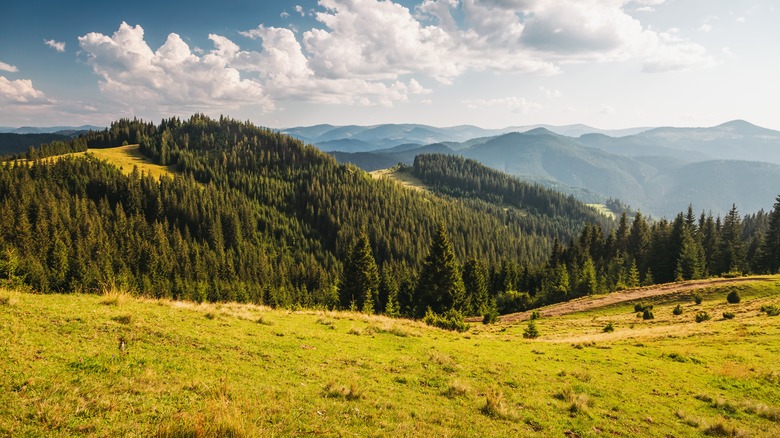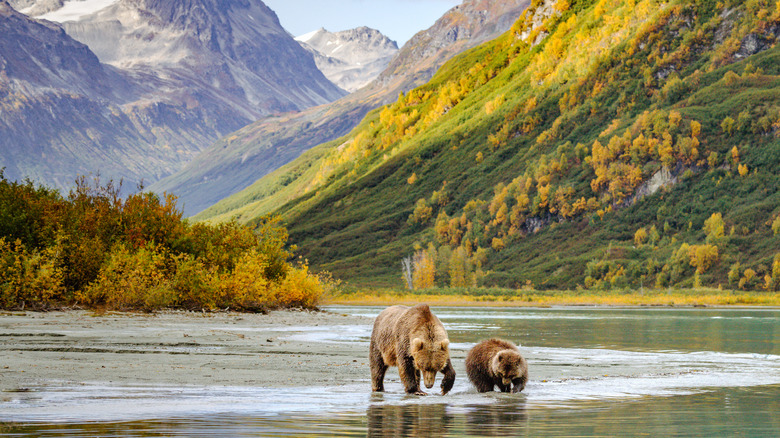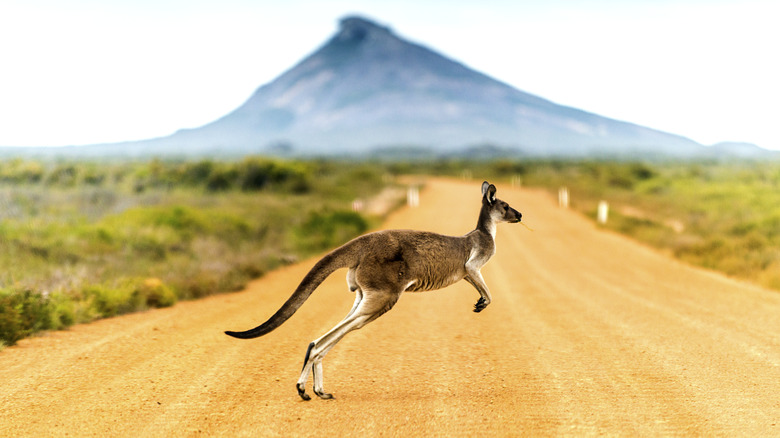The Best Wildlife By Continent: The Earth's Most Biodiverse Ecosystems Ranked
The Earth is full of life, but as any experienced traveler or nature documentary watcher can testify, some places have far more of it than others. While life does cling to everything it can, an assortment of complex environmental issues and interference from other species — here's looking at you, humanity — mean that there are numerous variables to the amount and types of biodiversity of different areas. What makes things even trickier is that we really have no idea of how many types of organisms live on Earth. In 2011, some scientists estimated that up to 86% of all species could still be undiscovered.
Despite all these difficulties in determining just how much life the Earth as a whole has, science can hazard a confident guess about the biodiversity of different continents. Let's take a look at the information out there, and see if we can find out which continent has the best wildlife.
Antarctica
Likely to the surprise of no one, the iciest continent doesn't fare particularly well when it comes to matters of biodiversity. That's not to say Antarctica is completely devoid of life, though. On the contrary, there's a surprising amount of biodiversity in the tiny fraction of the continent that isn't covered by ice, from various plants and tiny organisms to a handful of animals (not to mention flowers beginning to bloom in Antarctica). The seas around Antarctica actually have plenty of animal life, but when it comes to land, well ... let's just say that unless you like penguins and various types of tiny critters, you're going to be disappointed.
In fact, even many penguins think twice before setting up shop in Antarctica. There are 18 penguin species, and while several of them do hang around on the continent's warmest areas, the smaller Adélie penguins and large Emperor penguins are the only ones that truly reside there. With even most types of the continent's iconic black-and-white bird steering clear of its unforgiving wilderness, Antarctica is far and away the least biodiverse continent on Earth.
Europe
Since Antarctica's unique circumstances mean that its place as dead last on this list is virtually a given, Europe stands as the moral loser of the continent biodiversity Olympics. Notably less diverse than other heavily populated continents in terms of animal and plant life, Europe at least keeps fairly good track of its wildlife and plants. The European Union keeps tabs on the continent's flora and fauna, with some 800 listed mammal and bird species, 300 reptiles and amphibians, and a whopping 100,000 invertebrates — plus all the plants, fish, and other forms of life.
Unfortunately, Europe is not a very good place to live for many of these species, since there are also many people living there, and agriculture and urbanization affect much of the continent. As it stands, an estimated 25% of the continent's known species face a risk of extinction, and the ever-expanding European Red List of threatened species has well over 10,000 entries.
North America
Depending on where you live, North America might not look like much in terms of biodiversity — but "diversity" is the operative word, here. The continent's vast range of climates features 29 out of the 30 possible global climate zones, which means that there are lots of environments for different types of species to thrive in.
Humans have changed the continent's biosystem greatly, as massive forest areas and formerly huge populations of certain animals have reduced to bits and pieces, if even that. However, North America continues to absolutely mop the floor with Europe when it comes to the sheer richness of its animal life and plant variety. Where Europe has around 800 different mammals and birds, North America boasts over 1,370. Europe has some 20,000 species of vascular plants in total, but North America can put 18,600 on the table just by counting the species that can be found near the U.S.-Mexico border.
Unfortunately, this may not be the case in the future. While the areas in Europe and Central Asia experienced a concerning 24% loss of biodiversity between 1970 and 2020, North America trumps that number with a 33% biodiversity loss over that same 50-year period. It's a troubling figure, and time will tell where North America stands on this list in a few decades' time.
Australia
Australia might be the smallest continent, but what it lacks in size it more than makes up with its unique and complex biodiversity. Estimates from 2021 put Australia's and the surrounding sea region's number of species as high as 700,000, with new ones discovered all the time. The year 2020 alone brought 763 new species in the taxonomy fold.
Despite these impressive numbers, however, Australia's biggest claim to fame is the great number of species that only live on this particular continent. The sheer numbers of entirely endemic species among these are frankly mind-boggling. An estimated 87% of Australia's mammals can't be found anywhere else, and the number gets as high as 93 to 94% with reptiles, frogs, and flowering plant life.
Australia employs numerous ways to protect its biodiversity, including a tight biosecurity program that prohibits travelers from exporting and importing various goods, plants, and animals that might endanger the continent's unique ecosystem. However, the region is subject to the same issues that plague other continents on this list, as well. Since Europeans arrived in Australia, over 100 species are known to have gone extinct, and the official list of threatened flora and fauna has well over 2,000 species on it. The continent has also been known to suffer from disastrous events that impact its ecosystem heavily. These include the many climate change-induced threats to the important Great Barrier Reef and the Black Summer fires of 2019 and 2020. The latter alone killed or impacted 3 billion vertebrates and 60 billion invertebrate animals.
Africa
Africa is a surprisingly difficult region to pin down, ecosystem wise. It and Asia could potentially switch places on this list, but for the purposes of this particular ranking, Africa takes the third place thanks to the comparative lack of accurate data.
The thing is, while we know that Africa has plenty of wildlife, we have no precise idea of how immensely biodiverse it is. The continent is full of different climate regions that range from dry desert to temperate grassland and tropical rainforest, and there are estimates that it hosts about 25% of the world's plants and animals. Then again, there are also estimates that it'd take around 150 years to figure out the full scale of Africa's biodiversity, so who knows how much life the continent really has?
On the other hand, it's worth keeping in mind that Africa has been hit particularly hard by the loss of life that's plaguing the world. The World Wildlife Fund has estimated that the continent's biodiversity has reduced by no less than 65% between 1970 and 2020.
Asia
Speaking of wild cards, here's Asia. Thanks to its sheer size, exact continent-wide figures are not really out there. What's more, central Asia can be lumped together with Europe, and eastern Asia can be grouped with Pacific regions like Australia, not to mention that partial regions like East Asia and South Asia are often treated as their own areas in matters of biodiversity. This is, of course, understandable considering the sheer size of the continent and the amount of people living there, but it doesn't make things any easier to keep track of.
What is clear that Asia is extremely biodiverse, and South Asia alone is home to roughly 15.5% of all the world's animals, as well as 12% of the plants — with over 5,400 known species of mammals and birds alone, as of 2016. Unfortunately, the continent is also losing its biodiversity at a frankly stunning rate. As of 2022, East Asia alone had 147,517 different species on the International Union for Conservation of Nature's Red list of Threatened Species. As seems to be the trend, the continent is being affected by the same reasons behind declining levels of biodiversity as the rest of the planet – the more humans take over, the worse news it is to other species.
South America
With its vast assortment of climates and a little thing called the Amazon rainforest which hosts a cool 3 million species or so, South Africa holds all the aces when it comes to sheer biodiversity. The Amazon rainforest alone is responsible for 10% of the whole planet's known biodiversity ... and that could be just scratching the surface, seeing as the overwhelming majority of the area's plant species alone are still unknown to science.
Pull the camera back a little, and the numbers are even more overwhelming. Looking at the entirety of Latin America — which combines the Caribbean, Mexico, and Central America with South America — we get an area that hosts no less than 60% of the world's wildlife, with several biodiversity hotspots with their own intricacies. In other words, the rest of the world could form a biodiversity supergroup, and it still couldn't hope to touch this region.
Of course, there's the usual "but." The sheer amount of species in the region means that it's also been experiencing the kind of biodiversity loss that makes the other continents pale in comparison. The Latin American biodiversity has reduced by 94% between 1970 and 2020, which has contributed to bringing Earth's total biodiversity drop of 68% during this time — as well as the planet's current extinction crisis.







